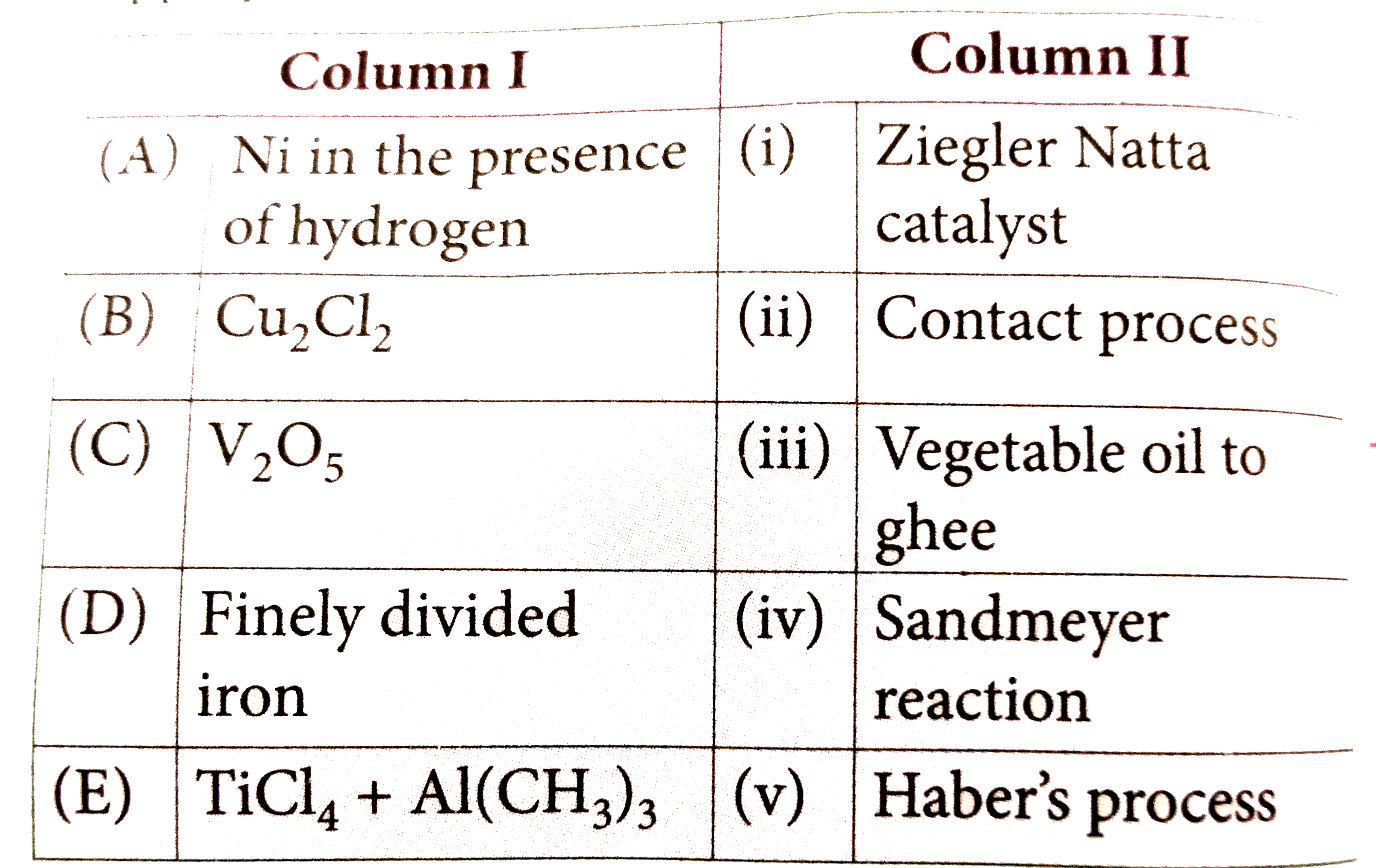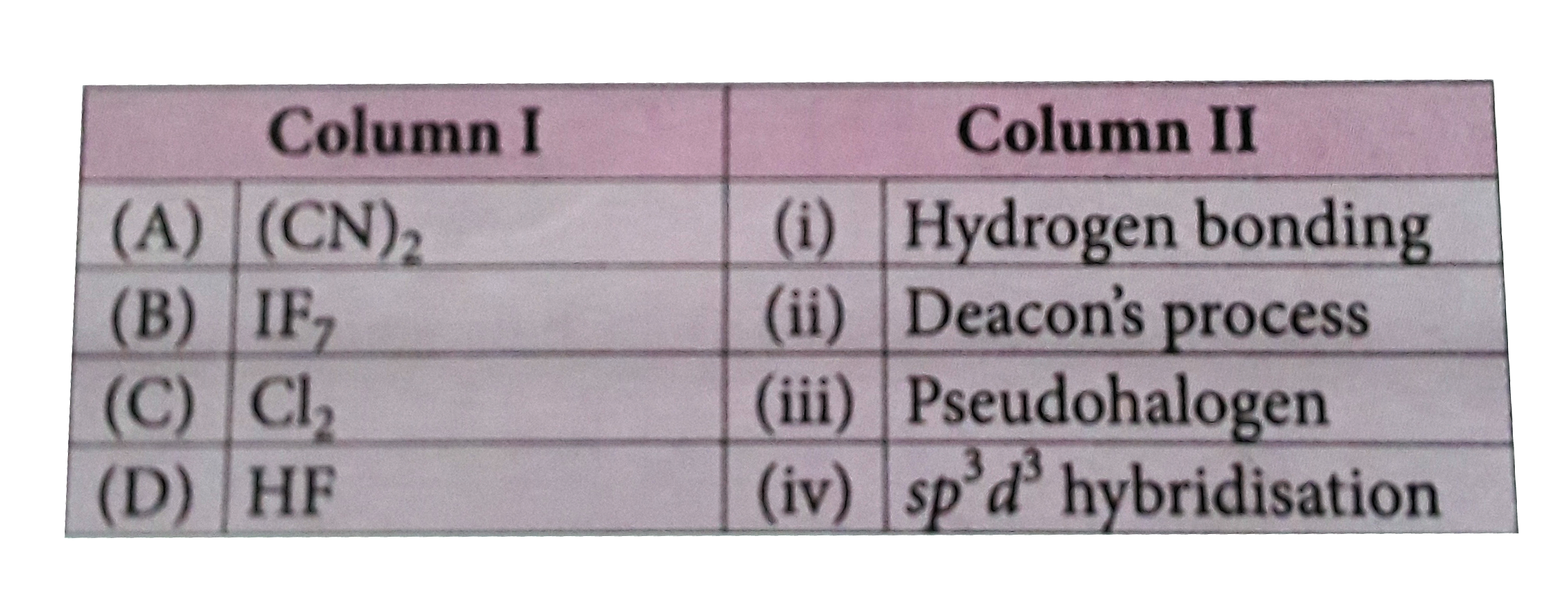Match the bond enthalpies given in column II with the molecules given in column I and mark the appropriate choice.
Column IColumn II (A)Hydrogen (H2)(i)498.0 kJ mol−1(B)Oxygen(O2)(ii)946.0 kJ mol−1(C)Nitrogen(N2)(iii)435.8 kJ mol−1
(A)→(i),(B)→(ii),(C)→(iii)
(A)→(iii),(B)→(ii),(C)→(i)
(A)→(i),(B)→(iii),(C)→(ii)
(A)→(iii),(B)→(i),(C)→(ii)
The correct Answer is:D
To solve the problem of matching the bond enthalpies with the corresponding molecules, we can follow these steps:
Step 1: Understand Bond Enthalpy
Bond enthalpy (or bond energy) is defined as the amount of energy required to break one mole of a specific type of bond in a molecule. The stronger the bond, the higher the bond enthalpy.
Step 2: Analyze the Molecules in Column I
- A: Hydrogen (H₂) - Contains a single bond between two hydrogen atoms.
- B: Oxygen (O₂) - Contains a double bond between two oxygen atoms.
- C: Nitrogen (N₂) - Contains a triple bond between two nitrogen atoms.
Step 3: Analyze the Bond Enthalpies in Column II
- i: 498.0 kJ mol⁻¹
- ii: 946.0 kJ mol⁻¹
- iii: 435.8 kJ mol⁻¹
Step 4: Compare the Strength of Bonds
- Single bonds (like in H₂) are the weakest.
- Double bonds (like in O₂) are stronger than single bonds but weaker than triple bonds.
- Triple bonds (like in N₂) are the strongest.
Step 5: Match the Bond Enthalpies
1. Hydrogen (H₂) has the weakest bond (single bond), so it will correspond to the lowest bond enthalpy. Thus, it matches with (iii) 435.8 kJ mol⁻¹.
2. Oxygen (O₂) has a double bond, which is stronger than a single bond but weaker than a triple bond. It matches with (i) 498.0 kJ mol⁻¹.
3. Nitrogen (N₂) has the strongest bond (triple bond), so it corresponds to the highest bond enthalpy. Thus, it matches with (ii) 946.0 kJ mol⁻¹.
Final Matches
- A (H₂) - iii (435.8 kJ mol⁻¹)
- B (O₂) - i (498.0 kJ mol⁻¹)
- C (N₂) - ii (946.0 kJ mol⁻¹)
Conclusion
The correct matching is:
- A → iii
- B → i
- C → ii
Bond enthalpy (or bond energy) is defined as the amount of energy required to break one mole of a specific type of bond in a molecule. The stronger the bond, the higher the bond enthalpy.
- A: Hydrogen (H₂) - Contains a single bond between two hydrogen atoms.
- B: Oxygen (O₂) - Contains a double bond between two oxygen atoms.
- C: Nitrogen (N₂) - Contains a triple bond between two nitrogen atoms.
- i: 498.0 kJ mol⁻¹
- ii: 946.0 kJ mol⁻¹
- iii: 435.8 kJ mol⁻¹
- Single bonds (like in H₂) are the weakest.
- Double bonds (like in O₂) are stronger than single bonds but weaker than triple bonds.
- Triple bonds (like in N₂) are the strongest.
1. Hydrogen (H₂) has the weakest bond (single bond), so it will correspond to the lowest bond enthalpy. Thus, it matches with (iii) 435.8 kJ mol⁻¹.
2. Oxygen (O₂) has a double bond, which is stronger than a single bond but weaker than a triple bond. It matches with (i) 498.0 kJ mol⁻¹.
3. Nitrogen (N₂) has the strongest bond (triple bond), so it corresponds to the highest bond enthalpy. Thus, it matches with (ii) 946.0 kJ mol⁻¹.
- A (H₂) - iii (435.8 kJ mol⁻¹)
- B (O₂) - i (498.0 kJ mol⁻¹)
- C (N₂) - ii (946.0 kJ mol⁻¹)
The correct matching is:
- A → iii
- B → i
- C → ii
Topper's Solved these Questions
- CHEMICAL BONDING & MOLECULAR STRUCTUREBOOK - NCERT FINGERTPS ENGLISHCHAPTER - CHEMICAL BONDING & MOLECULAR STRUCTUREEXERCISE - HIGHER ORDER THINKING SKILLS
10 Videos
- CHEMICAL BONDING & MOLECULAR STRUCTUREBOOK - NCERT FINGERTPS ENGLISHCHAPTER - CHEMICAL BONDING & MOLECULAR STRUCTUREEXERCISE - EXEMPLAR PROBLEMS
14 Videos
- CLASSIFICATION OF ELEMENTS AND PERIODICITY BOOK - NCERT FINGERTPS ENGLISHCHAPTER - CLASSIFICATION OF ELEMENTS AND PERIODICITY EXERCISE - Assertion And Reason
15 Videos
Similar Questions
Match the molecules given in column I with their shapes given in column II and mark the appropriate choice.

View SolutionMatch the column I with column II and mark the appropriate choice.

View SolutionMatch the column I with column II and mark the appropriate choice.

View SolutionMatch the column I with column II and mark the appropriate choice.

View SolutionMatch the column I with column II and mark the appropriate choice.

View SolutionMatch the column I with column II and mark the appropriate choice.

View SolutionMatch the column I with column II and mark the appropriate choice.

View SolutionMatch the column I with column II and mark the appropriate choice.

View SolutionMatch the column I with column II and mark the appropriate choice.

View SolutionMatch the column I with column II and mark the appropriate choice.

View Solution
